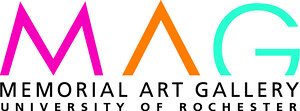The Path to Paradise
February 16–May 24, 2020
500 University Ave, Rochester
New York, NY 14607
USA
The Memorial Art Gallery (MAG) of the University of Rochester is pleased to present The Path to Paradise: Judith Schaechter’s Stained-Glass Art, the first survey and major scholarly assessment of this groundbreaking artist’s 37-year career. Organized by MAG, the exhibition will be on view in Rochester from February 16 to May 24, 2020, after which it will travel to Toledo Museum of Art, June 27 to October 4, 2020, and Des Moines Art Center, February 5 to May 9, 2021.
From her start in the 1980s, Judith Schaechter (b. 1961) has stretched the medium of stained glass into an incisive art form for the 21st century, boldly paving her path in the diverse arena of contemporary art. With deep respect for history, a provocative rebelliousness, and a feminist sensibility, Schaechter has aptly been called a “post-punk stained-glass sorceress.” Her meticulous and awe-inspiring stained-glass panels are intentional seductions, alternative visions of beauty, and radical statements of female experience.
Drawing from both private and institutional collections, MAG will present over 40 of Judith Schaechter’s stained-glass panels along with a selection of related drawings, sketchbooks, and process materials. The exhibition and its companion publication will explore the range of critical registers Schaechter’s work spans, illuminating and contextualizing the artist’s unique contributions to the contemporary canon. The 170+page catalogue is published by RIT Press in association with the Memorial Art Gallery.
With more than 225 panels spanning her career, Schaechter has developed a singular figural style and a rich personal iconography. Her respect for the traditional medium of stained glass is matched by her drive to innovate. She is well versed in the historic techniques of stained glass, however, her panels—hung from the wall in custom-made light boxes—are contemporary art forms that stand alone. With artistic influences as wide-ranging as pulp fiction covers, neuroscience, Northern Renaissance masters, MAD magazine, ancient mythology, and medieval manuscripts, Schaechter’s work calls for a process that is equally diverse, incorporating online image sourcing, intensive doodling, Photoshop acrobatics, and her innovative, masterful manipulation of glass. She said she thinks of her practice “as an extreme sport. I’m not messing around. I deliberately make it as hard as possible… .”
Schaechter’s work is represented in over a dozen museums including the Carnegie Museum of Art, Corning Museum of Glass, Mint Museum, Museum of Arts and Design, Pennsylvania Academy of the Fine Arts, Philadelphia Museum of Art, Renwick Gallery of the Smithsonian American Art Museum, Speed Art Museum, and Toledo Museum of Art, and in major exhibitions around the world. Her awards include two NEA Visual Artists’ Fellowships, a Louis Comfort Tiffany Foundation Award, a Joan Mitchell Foundation Grant, a Guggenheim Fellowship, and an American Craft Council College of Fellows Award.
Jessica Marten, Curator in Charge/Curator of American Art at MAG, remarked: “This project is long overdue. Schaechter, whose earliest work in this exhibition was made in 1983, stands with pioneers like Faith Ringgold and Miriam Schapiro in questioning the binary and often gendered divisions between art and craft, formalism and the decorative, and masculine and feminine. Her contributions and transgressions are distinctly American, feminist interventions into the history of contemporary art, craft, and the medium of stained glass.”
Lead support is provided by the Henry Luce Foundation, with additional funding from the Gallery Council of the Memorial Art Gallery, Pamela Miller Ness and Paul Marc Ness, the Art Alliance for Contemporary Glass, James C. and Geraldine Biddle Moore, and Elizabeth L. Stauderman.
The exhibition is also made possible by the Margaret Davis Friedlich and Alan and Sylvia Davis Memorial Fund, the Robert A. and Maureen S. Dobies Endowment Fund, the Irving and Essie Germanow Fund, the Grant Holcomb Endowment, the Kayser Fund, the Elizabeth and Eric Rennert Family Fund, and the Robert L. and Mary L. Sproull Fund.
The exhibition is also supported in part by an award from the National Endowment for the Arts.



